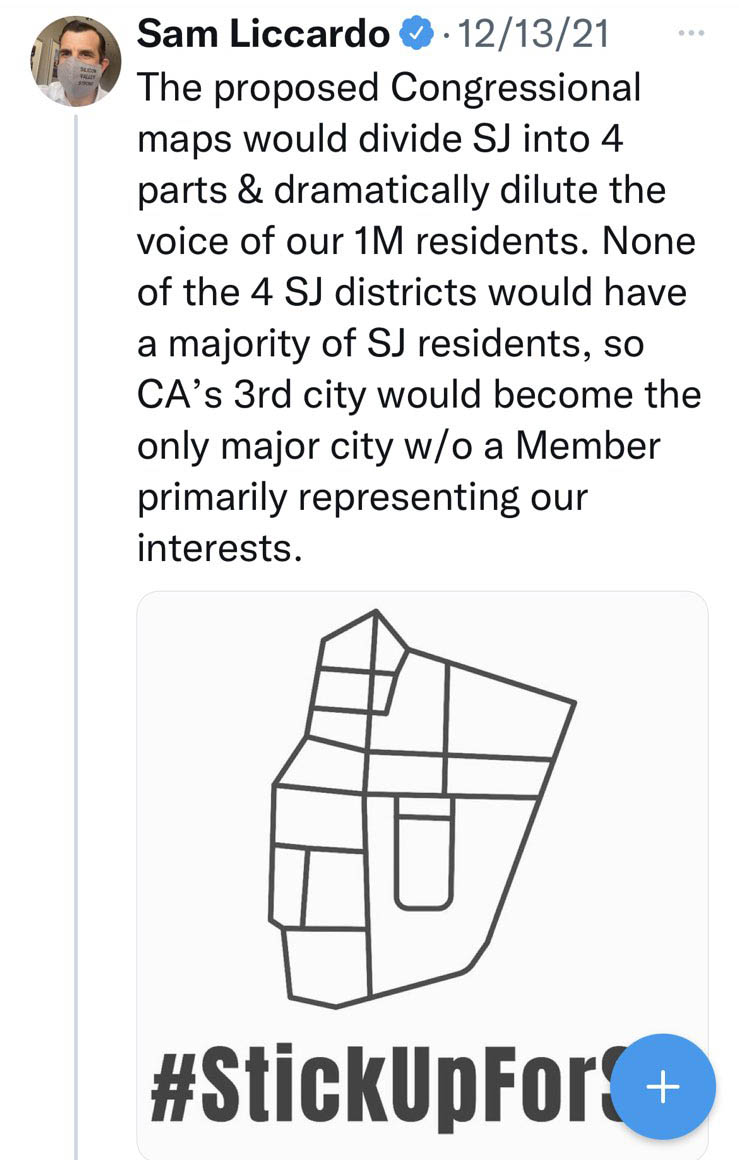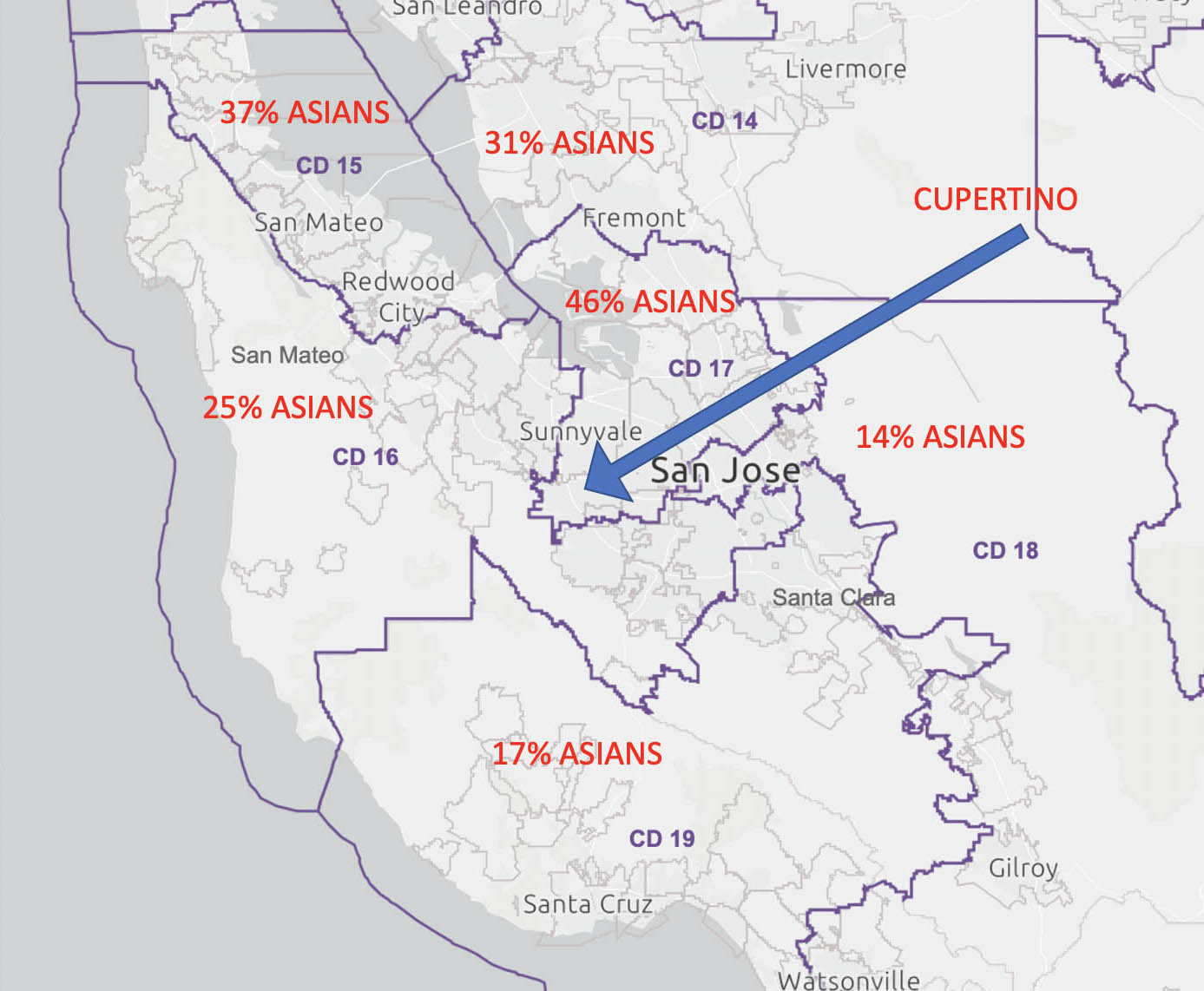

Disenfranchisement of minority communities will continue in 2022. Democracy is clearly not working!
The independent redistricting commission voted and approved California’s congressional district map and has ignored the Asian voice of Silicon Valley. Silicon Valley deserves two Asian majority-minority congressional districts. Seemingly, the independent redistricting commission has blocked Asians out from the newly carved CD-16 - which is largely derived from the old CD-18.
Here is how:
Cracking the Asian vote bank: Here is the data based on the final maps voted unanimously by the commission: CD-15 has 37% Asians, CD-19 has 17% Asians, CD-16 has only 25% Asians, while CD-17, which currently has Indian-American Representative Ro Khanna, is at a whopping 46% Asians. CD-18 that borders district 16 has a 14% Asian population, chunks of which could have been included in CD-16. Also portions from San Jose that were excluded from 16 (West San Jose) and added to the adjoining CD-17 has a sizable Asian population as well.
The commission has packed Asians into CD-17 but are cracking Asians across other districts, effectively diluting CD-16. The final lines are disenfranchising Silicon Valley Asians as district 16 could be that 2nd Asian majority-minority district, but by excluding West San Jose, San Jose- Almaden Valley (both of which played large roles in the 2020 election), San Jose-Evergreen (was proposed briefly with one of the 2021 iterations), San Jose-Little Saigon (was proposed briefly with the same 2021 iteration), and Cupertino, the commission has prevented the chances of an Asian-American representative.
An iteration discarded: The commission had considered an iteration from December 17th with an Asian majority-minority district that was discarded. In this iteration, San Jose was split into two parts upon the request of San Jose’s Mayor Sam Liccardo, versus four, and CD-16 ended up with an Asian majority of 32%. The commission, by discarding this iteration and by picking the final congressional lines, kept the incumbent within the congressional district.
The issue of Cupertino: Cupertino’s Asian population is currently 68%. If you take a look at the CD-16 and CD-17 map, you can clearly see why the allegation of gerrymandering has been heard throughout the process. Cupertino has been forcibly kept out of the CD-16 district and placed into CD-17. Cupertino has been lumped with East Bay cities like Fremont and Newark with whom they have no shared interests as part of congressional district 17. In fact, the West Valley cities of Cupertino, Los Gatos, Saratoga, Campbell and Monte Sereno deserve to stay together due to the issues they deal with, such as shared schools, shared sheriff services, freeway systems, expressways, utility companies and ongoing environmental challenges, such as that imposed by the Lehigh Cement plant. Cupertino is the only city that has been excluded from CD-16 whereas the rest of the West Valley cities have been placed into CD-16. Many verbal and written pleas were ignored by the commission.
 Why is Cupertino special? Cupertino’s mayor Darcy Paul had sent a message on October 18th, 2021 to the commission that is available as part of the public comment: "I’m writing this on my own behalf as a resident. Please move Cupertino into CD18. It’s obvious that the current lines of CD17 and CD18* were drawn to concentrate Asian votes into one district. That is wrong and it is racist. Cupertino obviously and naturally fits in with CD18. The effort to connect it across geographies to Fremont is flagrantly self-serving. Please fix this.” Vice Mayor Liang Fang Chao also called into a commission meeting asking Cupertino to be placed into a Silicon Valley congressional district, rather than into CD-17 with Fremont.
Why is Cupertino special? Cupertino’s mayor Darcy Paul had sent a message on October 18th, 2021 to the commission that is available as part of the public comment: "I’m writing this on my own behalf as a resident. Please move Cupertino into CD18. It’s obvious that the current lines of CD17 and CD18* were drawn to concentrate Asian votes into one district. That is wrong and it is racist. Cupertino obviously and naturally fits in with CD18. The effort to connect it across geographies to Fremont is flagrantly self-serving. Please fix this.” Vice Mayor Liang Fang Chao also called into a commission meeting asking Cupertino to be placed into a Silicon Valley congressional district, rather than into CD-17 with Fremont.
The West Valley cities together are a large and diverse community with shared interests in Asian arts, cultural practices, language, and food in which immigrants and others have thrived since these cities provide the cultural support network which includes Churches, temples, community centers, language, dance and music academies. Many community members work in tech-related jobs which creates economic opportunities for many in the region and beyond. The technology workers commute between these cities so there are shared concerns about traffic and housing. These cities have common needs around language, health, culture, and entrepreneurial inclinations which are aided through the proximity of these cities.
* Darcy’s reference to CD-17 and CD-18 are a reference to CD-17 and CD-16 in the new map
This article explains the redistricting guidelines and potential violation.
Below is the map viewer which has the final congressional district map as released by the Redistricting Commission.
